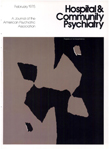A Study of Hospitalized Paranoid Schizophrenics With Grandiose Symptomatology
Abstract
Twenty-one paranoid schizophrenics who were being treated in a therapeutic community were divided into groups with grandiose and nongrandiose symptomatology, based on ratings on the Inpatient Multidimensional Psychiatric Scale. The nine nongrandiose patients showed significantly greater improvement during hospitalization. A follow-up of five non-grandiose and nine grandiose patients one year after discharge revealed a trend toward greater improvement by the nongrandiose group. The authors feel that a patient's grandiosity creates a barrier that keeps the therapist and the members of the therapeutic community at a distance and makes him less accessible to therapeutic intervention. The field dependence of patients was also rated, but was of no prognostic significance.
Access content
To read the fulltext, please use one of the options below to sign in or purchase access.- Personal login
- Institutional Login
- Sign in via OpenAthens
- Register for access
-
Please login/register if you wish to pair your device and check access availability.
Not a subscriber?
PsychiatryOnline subscription options offer access to the DSM-5 library, books, journals, CME, and patient resources. This all-in-one virtual library provides psychiatrists and mental health professionals with key resources for diagnosis, treatment, research, and professional development.
Need more help? PsychiatryOnline Customer Service may be reached by emailing [email protected] or by calling 800-368-5777 (in the U.S.) or 703-907-7322 (outside the U.S.).



